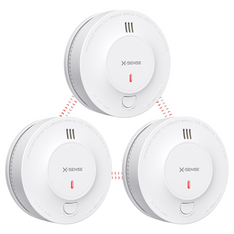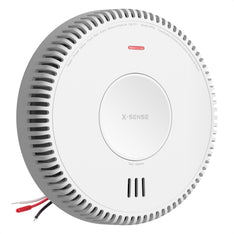Electrochemical Carbon Monoxide Sensor
Tue, Apr 27, 2021
How to protect yourself from an invisible killer enemy, Carbon monoxide? You will learn this from this article. You need a detector that has the sensor in carbon monoxide detector. The sensor is used to check the presence of this killer gas carbon monoxide that is present everywhere, whether you live or where you work. For the sensor to be effective, you should understand the benefits of Electrochemical CO sensor, that scores better than the others used for this purpose.
Sensors in Carbon Monoxide Detectors
Engineers Edge pointed out that there are quite a few types of devices for detecting the existence of carbon monoxide. Most sensors function in the same way to alert the users of potentially hazardous levels of emission of CO.
High CO levels can be dangerous to the people around, depending on the level of the gas present and the duration of exposure. Engineers Edge also highlighted that even a smaller concentration of CO will become more harmful if exposed to for longer duration. Whereas the high concentrations can be harmful when exposed even for a short time. So the sensors or the detectors of CO are designed to check the extent of CO levels over a long duration and raise an alarm much before the harmful accumulation of the CO in an environment, helping the people around, on time to ventilate the surrounding to safe level or to move way.
In the recent past, there were some CO sensors to choose from, that are
1. Opto-chemical Sensors
These detectors use a chemical which changes its color, when exposed to CO. Although these are inexpensive, they are not quite accurate in sensing the gas
2. Biomimetic Sensors
The system of cyclodextrins, a combination of chromophore and metal salts, that is used in this type of sensors lets the sensor to become darker in colour depending on the amount of CO in the air.
3. Semiconductor Sensors
Semiconductor sensors make use of an integrated circuit made up of tin monoxide semiconductor that is mounted on an insulated base. But this sensing element has to be heated up to 400 degrees Celsius to be able to detect existence of carbon monoxide correctly. Since this detection also requires high power, it has the limitation to use for this purpose.
Electrochemical Sensor: Functionality and Benefits
Over and above these detectors, there is yet another advanced sensor that is the electrochemical CO sensor. It uses quite a complex chemical process giving a highly precise measurement of the presence of CO levels.
This sensor has three electrodes that are the working electrode, the reference electrode and the counter electrode. All these three electrodes are immersed together in an electrolyte conductor liquid. The working electrode is made up of platinum and acts as a catalyst for the CO gas. It is supported by a gas-permeable that also has a waterproof membrane enabling CO to move in and to oxidise working of the platinum electrode electrochemically.
As the oxidation happens, the electrons emerging from the electrochemical reaction drift through the external circuit of the sensor, and allow the sensor on the board to send signal about the CO presence.
The electrochemical sensor, in addition to the electrodes also has a highly sensitive filter that is capable of eliminating other gases that are likely to cause a false CO alarm. So, this kind of electrochemical detector is able give unbelievably accurate measurement of CO.
Significant advantages of choosing the electrochemical detector among the other types of sensors are:
1. Accuracy
Because of the filter playing the key role of removing all other gases even before they can reach the main working sensor, the measurement is exact. The accurate measure is ensured by detecting only carbon monoxide and thereby avoiding wrong reactions and undesirable false alarms.
2. Flexible Applications
The electrochemical sensor functions in normal ambient temperatures without need for high power that is the essential requirement for semiconductor based sensors. So these are widely used in common industrial environment without causing false alarms of CO that has been the usual problem with other CO sensors that were in use before.
3. A Leading Choice
In the past, the semiconductor sensors were the commonly used CO sensor. The electrochemical sensors have taken over because of the competitive advantage of the cost. Therefore these have emerged as the globally preferred solution especially in the U.S., Australia, and Europe.
Why Do We Need to Detect CO?
Carbon monoxide is an invisible killer because its properties that have undetectable, odourless and tasteless attributes. It silently gets into the human body and replaces oxygen and affects flow of the red blood cell. Any of the common symptoms like vomiting, headache, weakness and unconsciousness is only an indication and a starter for eventual deaths. So, Carbon monoxide should be detected on time so that you do not run the risk of losing your life.
The presence of the carbon monoxide is measured in parts per million or the ppm, which should be around 50 ppm. The concentration at level of even 700 ppm can be disastrous to human living anywhere.
Prevention is better than cure. Incomplete burning of the fuel in automobiles and industries results in carbon monoxide. The best remedy is to ensure that combustions are made utmost efficient.

X-Sense CO03D Carbon Monoxide Detector
- Digital LCD clearly displays real-time CO concentration levels and battery power.
- 10-year sensor life with replaceable batteries provides uninterrupted 24/7 protection.
- Detects CO threats accurately with the advanced Figaro electrochemical CO sensor.
- Easy to install onto any wall or ceiling without hardwiring.
- Meets safety standards UL 2034 (US) and EN 50291 (EU).
$29.99






